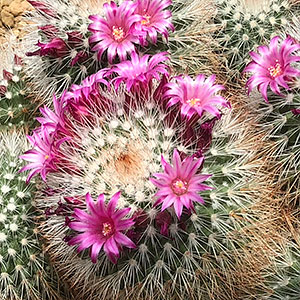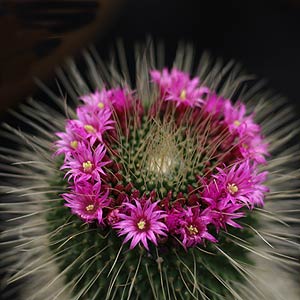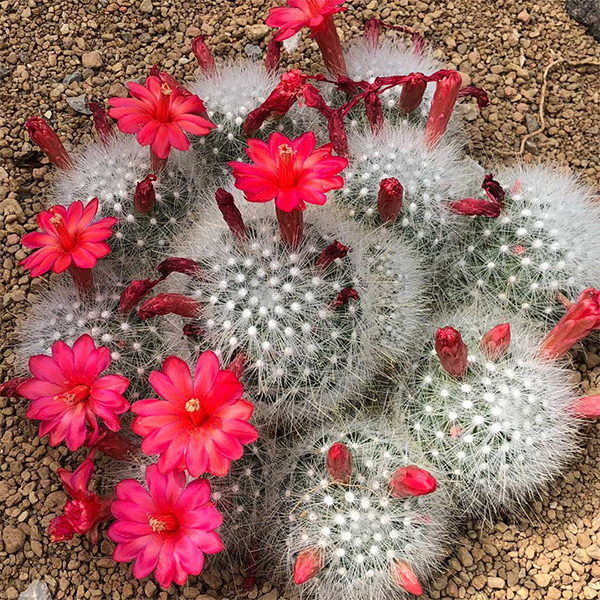
Mammillaria is a large and varied genus within the cactus family, over 250 species and one of the most widely grown cactus of all.
The popularity is due to the ease of care and propagation of most species. They are widely found for sale, even in the big boxes. However the rarer species are still the realm of the collector.
Originally from Mexico and surrounding countries Mammillaria are sometimes known as nipple cactus, fishhook cactus or pincushion cactus.
Mammillaria hahniana woodsii is one of the easier species tp grow as well as being one of the most attractive.
Being such a large genus it is difficult to give a general description of Mammillaria, however we include some photographs to give an idea of the diversity.

Mostly globe shaped and clump forming many Mammillaria species are grown as single specimens due to the dramatic natural appearance of individual plants.
Propagation and hybridisation has produced many spectacular flowering specimens and these are one of the most widely cultivated of all cactus.
Mammillaria bombycina (pictured right)is known as the silken pincushion cactus, a clump forming species with flowers emerging sequentially over 2 – 3 weeks and lasting for 4 – 5 weeks. The flowers tend to form in a neat circle around the top of the plant.
Care
The main care requirements for Mammillaria are well drained soil and full sun.
We would suggest :
- Growing in containers.
Using a specialist succulent and cacti soil mix. Repot every 3 – 4 years. - Being able to provide full sun, or very good light in winter.
Temperature

Although Mammillarias will grow outdoors in the warmer climates, they are are usually grown indoors in containers. They appreciate a temperature range that is not difficult to achieve indoors.
Look for a temperature range 68F – 77F (20 – 25 C) daytime and 53F – 59 F (12C – 15 C) night, never less than 40F (5C)
Light
As a rule, morning sun and filtered afternoon light in summer. In summer try to get them outdoors, good light but not the hot afternoon sun. Winter, indoors in good filtered or indirect light.
Watering
Like most succulents drainage and watering is the key to proper care. A free draining potting soil is essential. AT all times the soil should be allowed to almost dry completely between waterings. In winter you will only need to water every 4 weeks.
Increase water in spring to summer during the active growth period. Every second day in hot weather, however never allow the growing medium to become wet or water logged. They are a succulent that is dormant in Winter so in Fall begin to cut back the watering.
Mammillaria Varieties
Many of the easy to grow species are sold in garden centres, however the variety available from online suppliers far surpasses this.
You will rarely see Mammillaria bocasana, pictured above for sale in your local nursery. However it is available for sale online from specialist growers.
With over 150 species including: mammillaria elongata, mammillaria gracilis, mammillaria spinosissima, mammillaria bocasana, mammillaria zeilmanniana, mammillaria theresae.
Mammillaria are native to Mexico and to a lesser extent USA and other surrounding countries.
Propagation
The species can be propagated from seed.

